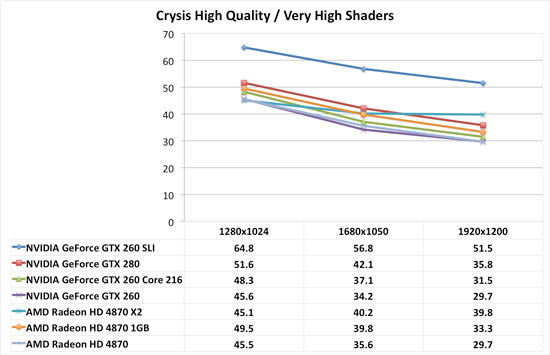The Radeon HD 4870 1GB: The Card to Get
by Derek Wilson on September 25, 2008 12:00 AM EST- Posted in
- GPUs
Crysis Performance
Ahh, Crysis. The ever contended benchmark. At the highest playable resolution with the settings we tested (1920x1200), the Radeon HD 4870 1GB leads the GTX 260 core 216 by about 5.7%. Interestingly, the GTX 280 only has a 7.5% lead over the 4870 1GB. The extra memory really seems to have made a difference here, and we aren't even looking at 2560x1600.












78 Comments
View All Comments
carmaster22 - Thursday, September 25, 2008 - link
How come you don't include the NVIDIA 9800 series cards anymore?They were proven to perform just as well and better than the GTX series and there's many people that have them.
SiliconDoc - Friday, October 3, 2008 - link
It's to make it as confusing as possible to we the consumer. No matter WHAT review site I go to - they are absolutely CERTAIN to leave out a couple of KEY cards in the reviews - so that it makes it absolutely near IMPOSSIBLE to make a reasonable decision without endless HOURS of finding, comparing, checking the system stats, of various reviews....It's like corporate code - but what really happens is the goobers are thinking, thinking, thinking - and they think so much and so !bleepin! hard, that they come up with some cool points, and interesting facts - but alas - you still don't know what you want to know.
Whatever, it's so frustrating - I'm sending $100 paypal to the first author that actually satisfies a good lineup in review.
Goty - Thursday, September 25, 2008 - link
The only 9800 series card that could outperform the 4870 was the 9800GX2, and even that fell behind the 4870 and the GTX200s when you started cranking up the resolution and IQ.daniyarm - Thursday, September 25, 2008 - link
8800gt SLI beat 4750 in several tests even at hi-res. People that own single or sli 8800 or 9800 want to know how the cards compare. What's the point of a review that compares only new gen cards and give absolutely no information for people that want to know if they need to upgrade or not.daniyarm - Thursday, September 25, 2008 - link
I meant 4870.Patrick Wolf - Thursday, September 25, 2008 - link
Where do you get your info?The 9800 GX2 can be had for under $300 and is also very comparable to the 8800gt SLI. If you have an SLI mainboard and an 8800gt, a very cheap and viable upgrade would be to throw in another 8800gt. If you lack the SLI mainboard, bite on the GX2 and sell your current card.
Same goes for the 9800 GTX and GTX+ if you're going SLI with them.
The following graphs speak for themselves. All the above solutions are still a great contender, worthy of inclusion.
Crysis: http://www.anandtech.com/GalleryImage.aspx?id=3192">http://www.anandtech.com/GalleryImage.aspx?id=3192
Oblivion: http://www.anandtech.com/GalleryImage.aspx?id=3192">http://www.anandtech.com/GalleryImage.aspx?id=3192
Patrick Wolf - Thursday, September 25, 2008 - link
Oops.Oblivion: http://www.anandtech.com/GalleryImage.aspx?id=3189">http://www.anandtech.com/GalleryImage.aspx?id=3189
JarredWalton - Thursday, September 25, 2008 - link
Considering you just linked a recent review that has all of the pertinent information, then throw in the cluttered nature of those charts, and I'm of the opinion that dropping most of the cards and just keeping the more recent stuff makes a lot of sense.FYI, outside of a few games (The Witcher 2xAA, ETQW 4xAA, COD4 4xAA) the 9800 GTX+ is very close to the performance of the GTX 260. That's understandable, since they have similar architectures. Here's the theoretical performance overview:
GTX 260:
192 SPs at 1242MHz = 715.4 GFLOPS
Core clock of 576 MHz = 36.9 GT/s texture fillrate
28 ROPs at 576 MHz = 16.1 GP/s pixel fillrate
448-bit RAM at 999MHz = 111.9 GB/s
9800 GTX+:
128 SPs at 1836MHz = 940 GFLOPS
Core clock of 738 MHz = 47.2 GT/s texture fillrate
16 ROPs at 738 MHz = 11.8 GP/s pixel fillrate
256-bit RAM at 1100MHz = 70.4 GB/s
So the GTX 260 has substantially more bandwidth (59%) and pixel fillrate (36%), while the 9800 GTX+ has more theoretical GFLOPS (31%) and texture processing power (28%). The GTX 260 ends up faster overall - I'm not sure it ever trails - but there are many games where the difference between the two is only about 10%. The 8800 GT, for the record, is usually 65 to 75% of the performance of GTX 260.
Spoelie - Thursday, September 25, 2008 - link
The 9800GT is a rebadged 8800GT, which sits below any ATi 4 series .The 9800GTX+ is competitive with the 4850, but that's a lower price/market segment (target resolution 1600x1200/1680x1050 ?).
This is an article about cards that run newer games on 1920x1200 and higher comfortably, and well, the 9 series just don't make that cut anymore. Anandtech included all possible contenders except maybe for some SLI configurations.
Jovec - Thursday, September 25, 2008 - link
AT is wrong in what many, if not most, of us want in these reviews. Simply, we have our specific system, and want to know if a single upgraded part or parts (when it comes to new platforms) justifies the purchase price. Obvioulsy impractical, but there is no reason AT can't build and keep 1-2 systems per year, for a 2-3 year moving window, of the most common mid-range builds and include those benchmarks as a reference in all reviews.The best example of this is the 8800GTS which I assume many of us still own. We don't care how the 4870 runs on the Intel Core 2 Extreme QX9770 @ 3.20GHz used in the review, we care if the card will boost our FPS enough to warrant purchasing for our computer. It's a different type of comparison than the GPU-limited and CPU-limited tests they currently run, but very useful to the majority of us.
We can say "My system is very close to the Fall '07 system, so if I buy this new card I'll get a similar performance increase."